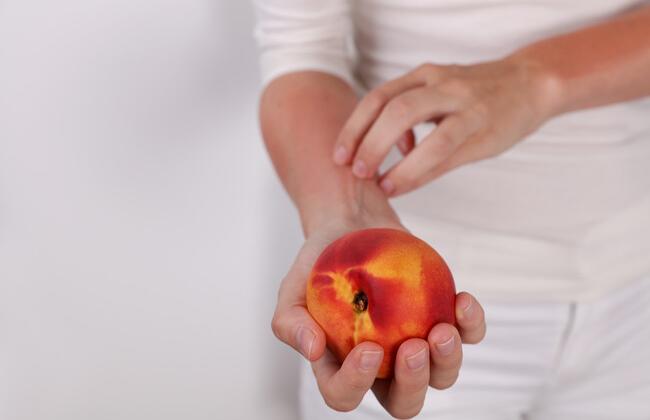European-Japanese Study on Peach Allergies with the Participation of the Paul-Ehrlich-Institut
Peach allergies are among the most common food allergies in Europe and Japan. An international research team including the Paul-Ehrlich-Institut has identified the sensitisation pattern for the five known peach allergens in Europe and Japan, examined their relationship to pollen and food, and developed a model using various parameters to predict the severity of symptoms. Allergy reports on the research results in its online edition from 19 June 2023.

Peach allergies are among the most common food allergies in Europe and Japan. There are five known allergy-causing peach proteins listed in the allergen database of the IUIS/WHO (International Union of Immunological Societies/World Health Organization): Pru p 1 to Pru p 4 and Pru p 7. Sensitisation, which varies by region, is associated with reactions of varying severity. In Northern and Central Europe, most allergy sufferers are sensitised to Pru p 1, which is related to the main allergen from birch pollen. In Mediterranean countries, sensitisation to Pru p 3 is dominant. A newer marker, Pru p 7, related to allergens from cypress and Japanese cedar pollen, has also been identified as a trigger for severe reactions. Component-resolved diagnostics (CRD) can be used to identify triggers of allergies at the molecular level. CRD can indeed help to better assess the risk of severe allergic reactions. However, study designs and results vary widely. The Vice President of the Paul-Ehrlich-Institut, Professor Stefan Vieths, led the work package for the continued development of CRD in food allergies as part of the international research project EuroPrevall (the prevalence, cost and basis of food allergy across Europe).
The goal of the study was to determine the sensitisation pattern for the five peach allergens in Europe and Japan, to investigate their relationship to pollen and food, and to predict risks for severe symptoms. The EuroPrevall project team carried out the investigation by conducting a standardised clinical evaluation of 1,231 patients who reported symptoms after peach consumption or were already known to be sensitised to peach in 12 specialised clinics in the EU and in a Japanese outpatient clinic. In 474 participants, specific immunoglobulins (IgE) against the peach allergens Pru p 1, 2, 3, 4 and 7 as well as against Cup s 7, an allergen from cypresses, were investigated. Immunoglobulin E (IgE) antibodies play a key role in allergic reactions.
Sensitisation to Pru p 3 dominated in Southern Europe, but was also quite common in Northern and Central Europe. Sensitisation to Pru p 7 was low and variable in European centres, but very dominant in Japan. A model was used to predict the severity of allergic reactions. The model included the age at which the peach allergy first occurred in conjunction with a probable mugwort, parietaria pollen, and latex allergy as well as sensitisation against Japanese cedar pollen, Pru p 4 and Pru p 7.
Pru p 7 was finally confirmed as a significant risk factor for severe peach allergies in Europe and Japan. The lipid transfer protein Pru p 3 tends to be a risk factor only in Southern Europe. The combination of clinical and demographic results with serology in one model allowed a better prediction of the severity of a peach allergy than component-resolved diagnostics (CRD) alone.
Original Publication
Kallen EJJ, Revers A, Fernández-Rivas M, Asero R, Ballmer-Weber B, Barreales L, Belohlavkova S, de Blay F, Clausen M, Dubakiene R, Ebisawa M, Fernández-Perez C, Fritsche P, Fukutomi Y, Gislason D, Hoffmann-Sommergruber K, Jedrzejczak-Czechowicz M, Knulst AC, Kowalski ML, Kralimarkova T, Lidholm J, Metzler C, Mills ENC, Papadopoulos NG, Popov TA, Purohit A, Reig I, Seneviratne SL, Sinaniotis A, Takei M, Versteeg SA, Vassilopoulou AE, Vieths S, Welsing PMJ, Zwinderman AH, Le TM, Van Ree R (2023): A European-Japanese study on peach allergy: IgE to Pru p 7 associates with severity.
Allergy 78: 2497-2509.
Text



